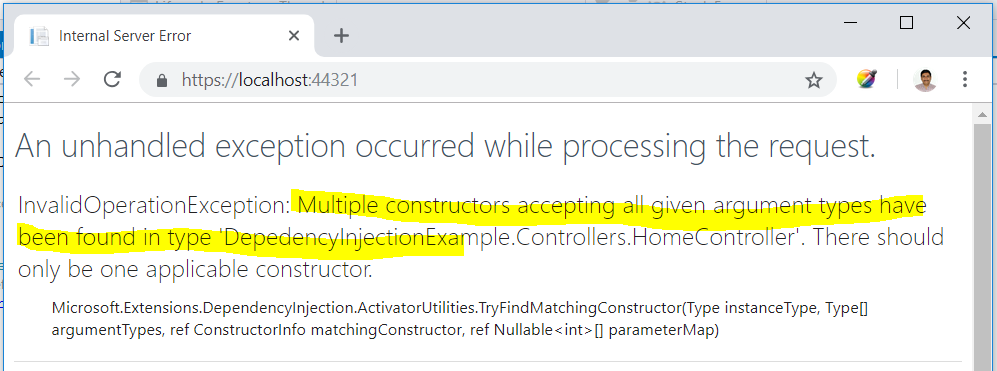29
DecASP.Net Core Dependency Injection
There are three types of DI: Construction Injection, Setter Injection, and interface-based Injection. The Construction Injection type of DI accepts its dependency at the constructor level, which means that when creating an object of the class, its dependency passes through the constructor of the class. It provides a strong dependency contract between objects.
The Setter Injection is also known as property injection. In this type of dependency injection, the dependency passes through a public property instead of the constructor. It allows us to pass the dependencies when required. It does not provide a strong dependency contract between objects. The interface-based dependency injection can be achieved by creating a common interface, and other classes implement this interface to inject the dependency. In this type of DI, we can use either constructor injection or setter injection.
Types of Dependency Injection .NET Core
In .NET Core Dependency Injection (DI), there are three primary types: Constructor Injection, Setter (Property) Injection, and Method Injection. While some sources mention Interface-Based Injection, this is not a separate type — instead, it’s a common practice that uses interfaces to define dependencies, making applications more flexible, testable, and maintainable.
1. Constructor Injection
Constructor Injection is the most common and recommended DI approach in ASP.NET Core. Dependencies are passed directly into the class via its constructor at the time of object creation.
Advantages: Strong dependency contract, ensures all required dependencies are provided upfront.
Best Use Case: When all dependencies are mandatory for the class to function..
public class MyService{private readonly IRepository _repository;public MyService(IRepository repository){_repository = repository;}}
2. Setter (Property) Injection
public class MyService{public IRepository Repository { get; set; }}
3. Method Injection
public void ProcessData(IRepository repository){// Use the dependency here}
Limited-time offer! Register for ASP.NET Core Certification Training and get a 30% discount.

| Course Name | Course Type | Book a Free Demo!! |
| ASP.NET Core Certification Training | Live Training | Free ASP.NET Core Training Demo! Sign up today. |
| .NET Developer Training With Certification | Live Training | Free ASP.NET Training Demo! Sign up today. |
Dependency Injection into Controllers
The dependency required by the ASP.NET MVC controller is requested explicitly via their constructors (Constructor injection type), and this dependency is available for the controller. Some of the dependencies are injected into only the controller action as a parameter. ASP.NET Core has built-in support for constructor-based dependency. The dependency required by the controller is simply adding a service type to the controller in the constructor. The ASP.NET Core will identify the service type and try to resolve the type. It would be a good design if the service were defined using interfaces but it is not always true.
Example:
In the following example, I have created the HelloWorld service. This service has a method called "SaysHello” that simply returns the "Hello " string. I have also implemented this service user interface.
namespace DepedencyInjectionExample.Service
{
public interface IHelloWorldService
{
string SaysHello();
}
public class HelloWorldService : IHelloWorldService
{
public string SaysHello()
{
return "Hello ";
}
}
}
The next step is to add this service to the service container so that when the controller is requested for service, it is available to use. We can add the service to the service container in the ConfigureServices method of the startup class. There are three different life options available: Transient, Scoped, and Singleton. We will discuss this later part of the article.
public void ConfigureServices(IServiceCollection services)
{
….
…
services.AddTransient<IHelloWorldService, HelloWorldService>();
…
…
}
If we do not register the service to the ASP.net core service container, it will throw the exception as follows.

Now this “HelloWorld” service is available to use in the controller. We can inject this service as a dependency in the constructor.
using DepedencyInjectionExample.Models;
using Microsoft.AspNetCore.Mvc;
using DepedencyInjectionExample.Service;
namespace DepedencyInjectionExample.Controllers
{
public class HomeController : Controller
{
IHelloWorldService _helloWorldService;
public HomeController(IHelloWorldService helloWorldService)
{
_helloWorldService = helloWorldService;
}
}
}
Once the service has been configured correctly and injected into the controller, it should display a Hello message as expected.

The constructor dependency injection behaviour resolved the service by either IServiceProvider or ActivatorUtilities. The ActivatorUtilities allows the creation of the object without service registration in the DI. The model binder, tag helper, and controller service are used by ActivatorUtilities. The service always required a public constructor. ASP.NET Core only supports a single constructor for the controller class that requests the service. If we have more than one constructor, ASP.NET Core MVC raises an error.

Inject the dependency in the controller action
Sometimes, we require dependency on a particular controller action method, not throughout the controller. ASP.NET Core MVC allows us to inject the dependency to a particular action using the "FromServices" attribute. This attribute tells the ASP.NET Core framework that parameters should be retrieved from the service container.
using DepedencyInjectionExample.Service;
using Microsoft.AspNetCore.Mvc;
namespace DepedencyInjectionExample.Controllers
{
public class DemoController : Controller
{
public IActionResult Index([FromServices] IHelloWorldService helloWorldService)
{
ViewData["MyText"] = helloWorldService.SaysHello() + "Jignesh!";
return View();
}
}
}
Property injection is not supported by ASP.NET Core, but we call the service instance manually and use service methods.
Get the service instance manually.
There is another way to get dependency services from the service container. In this method, the service is not injected in the controller constructor or in the action method as a parameter. Using the method "GetService" of the "HttpContext.RequestServices" property, we can get dependent services configured with the Service container. This is also known as property injection. Following is the example.
public IActionResult Index1()
{
var helloWorldService = (IHelloWorldService)this.HttpContext.RequestServices.GetService(typeof(IHelloWorldService));
ViewData["MyText"] = helloWorldService.SaysHello() + "Jignesh Trivedi!";
return View("index");
}
Service Lifetime
ASP.NET Core allows us to specify the lifetime for registered services. The service instance gets disposed of automatically based on a specified lifetime. So we do not care about cleaning these dependencies; it will take care of the ASP.NET Core framework. There are three types of lifetimes.
Singleton
ASP.Net core will create and share a single instance of the service through the application life. The service can be added as a singleton using the AddSingleton method of IServiceCollection. ASP.NET Core creates a service instance at the time of registration and subsequence requests use this service instance. Here, we do not require implementing a singleton design pattern and single instance maintained by the ASP.NET Core itself.
public void ConfigureServices(IServiceCollection services)
{
….
…
services.AddSingleton<IHelloWorldService, HelloWorldService>();
….
…
}
Transient
ASP.net core will create and share an instance of the service every time to the application when we ask for it. The service can be added as Transient using the AddTransient method of IServiceCollection. This lifetime can be used in stateless service. It is a way to add lightweight service.
In other words, the transient service will be created every time as soon as it will get the request for the creation.
public void ConfigureServices(IServiceCollection services)
{
….
…
services.AddTransient<IHelloWorldService, HelloWorldService>();
….
…
}
Scoped
ASP.net core will create and share an instance of the service per request to the application. It means that a single instance of service is available per request. It will create a new instance in a new request. The service can be added as scoped using the AddScoped method of IServiceCollection. We need to take care while the service is registered via Scoped in middleware and inject the service in the Invoke or InvokeAsync methods. If we inject dependency via the constructor, it behaves like a singleton object.
public void ConfigureServices(IServiceCollection services)
{
….
…
services.AddScoped<IHelloWorldService, HelloWorldService>();
….
…
}
Dependency injection into Views
ASP.NET Core can also able to inject the dependency to View. This is very useful for injecting service-related views such as localization. This method will bypass the controller call and fetch data directly from the service. We can inject the service dependency into the view using the @inject directive. The syntax is as follows to use this directive. Here we need to pass the service type that needs to be injected and the service instance name that is used to access the service method.
There are multiple ways to define or consume the data in the View layer of the MVC and the ways are there such as ViewModel, ViewBag, ViewData, etc. Concerning ASP.NET Core, One of the suitable ways to supply the data is by creating a custom service that is used via the DI (dependency injection). However, it is not a best practice and depends on certain parameters according to the component configurations.
@inject <type> <instance name>
Example
In the following example, I have used the same service that was created in the preceding section and injected it into the view using the @inject directive, and using the service instance, we can call the service method into the view.
@{
ViewData["Title"] = "DIToView";
}
@inject DepedencyInjectionExample.Service.IHelloWorldService helloWorldService
<h4>DI To View</h4>
<h5>
@helloWorldService.SaysHello() Reader!!!
</h5>

View injection can be used to populate the UI elements such as dropdown. The common dropdown such city/state dropdown can be populated from the service. Rendering such things from the service is a standard approach in ASP.NET Core MVC. Alternatively, we can use View Bag and Viewdata to populate the dropdown. The directive @inject is also used to override the injected service. For example, we are using the HTML helper service for rendering the HTML tags such as dropdown, textbox, etc. We can replace this service with our own service using the @inject directive.
Summary
Dependency injection is the design pattern that allows us to inject the dependency into the class from the outer world rather than creating it in class. This will help us to create loosely coupled applications so that they provide greater maintainability, testability, and also reusability. There is built-in support for dependency injection in ASP.NET Core. This support is not limited to middleware but also supports Controllers, views, and models as well. Please don't forget to share your feedback on this article. Enjoy Coding..!
The future of backend development is .NET Core. Don’t lag behind—enroll in our ASP.NET Core Online Course now!
FAQs
Take our Aspnet skill challenge to evaluate yourself!

In less than 5 minutes, with our skill challenge, you can identify your knowledge gaps and strengths in a given skill.







